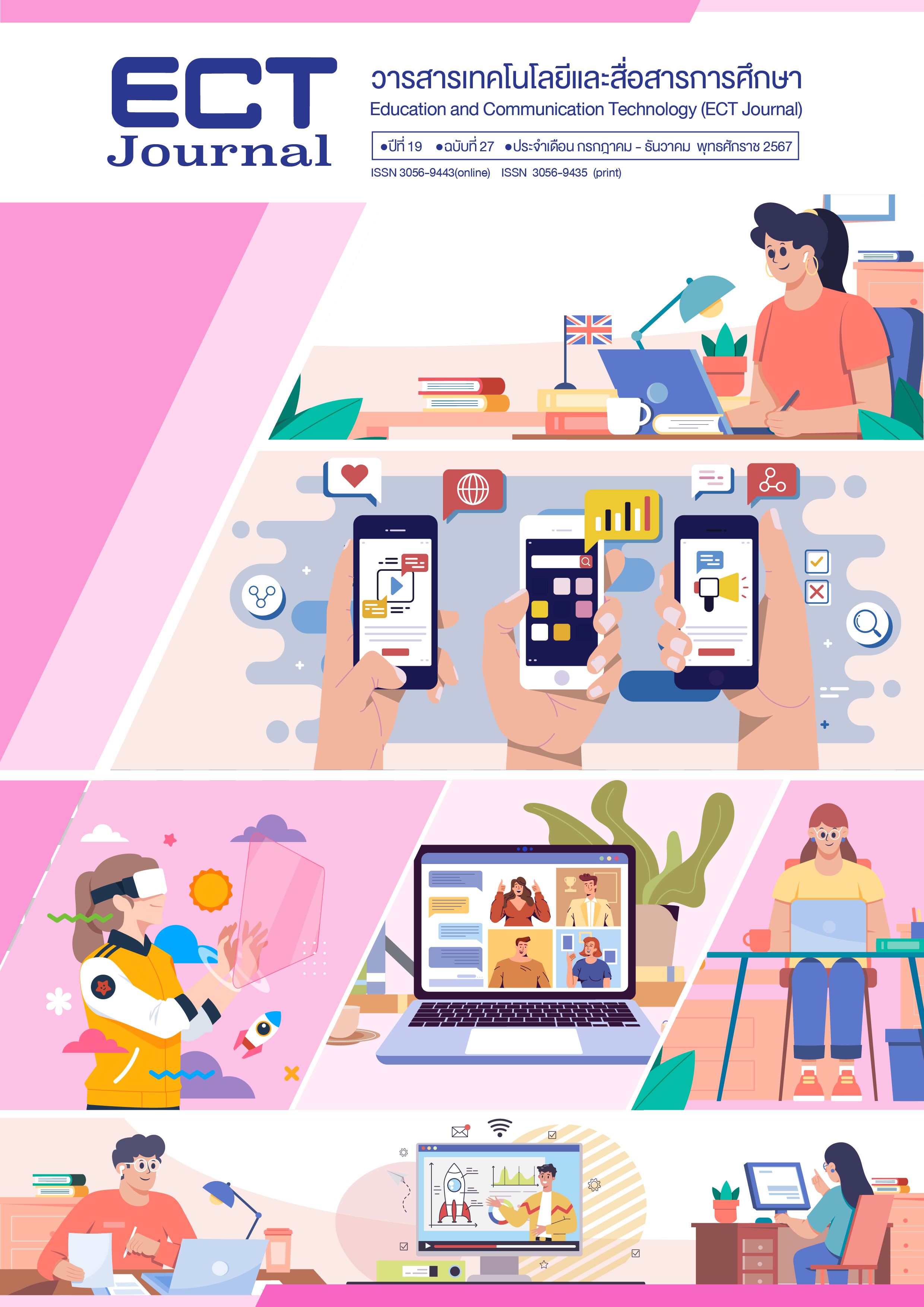The Development of Interactive Multimedia Lessons based on Brain-Based Learning to Enhance Analytical Thinking Skills for 4th-Grade Students
Keywords:
interactive multimedia lessons, brain-based learning, analytical thinking skillsAbstract
The objectives of this research were to: 1) develop interactive multimedia lessons based on brain-based learning to enhance analytical thinking skills for 4th-grade students, aiming to achieve the 80/80 standard criterion for media efficiency; 2) compare the analytical thinking skills of students before and after learning with these interactive multimedia lessons; and 3) study the satisfaction of students who used the interactive multimedia lessons. The sample consisted of 30 4th-grade students from Watkoh Suwannaram School, selected through simple random sampling. The research instruments included: 1) interactive multimedia lessons based on brain-based learning, 2) a media quality evaluation form, 3) an analytical thinking skill test, and 4) a satisfaction evaluation form. The data were statistically analyzed using means, standard deviation, and a t-test for dependent samples.
The research results revealed that: 1) the interactive multimedia lessons based on brain-based learning achieved an E1/E2 score of 83.08/84.11, which met the standard criterion; 2) the students' analytical thinking skills after studying with the interactive multimedia lessons were significantly higher than before learning, at the .05 level; and 3) the satisfaction of students who studied with the interactive multimedia lessons was rated at the "most" level.
References
เกริกชัย อุทัย. (2564). การพัฒนาบทเรียนมัลติมีเดีย เรื่องเทคโนโลยีสารสนเทศและการสื่อสาร สำหรับนักเรียนชั้นประถมศึกษาปีที่ 5 [วิทยานิพนธ์ปริญญามหาบัณฑิต ไม่ได้ตีพิมพ์]. มหาวิทยาลัยราชภัฏนครสวรรค์.
คำรณ สะอาด. (2561). การพัฒนาบทเรียนคอมพิวเตอร์มัลติมีเดีย เรื่อง พลเมืองดีในวิถีประชาธิปไตยกลุ่มสาระการเรียนรู้สังคมศึกษา ศาสนา และวัฒนธรรม สำหรับนักเรียนชั้นประถมศึกษาปีที่ 3 กลุ่มเครือข่ายโพธารามที่ 5 สำนักงานเขตพื้นที่การศึกษาประถมศึกษาราชบุรี เขต 2. ใน การประชุมวิชาการระดับชาติ ครั้งที่ 2 มหาวิทยาลัยราชภัฏกาญจนบุรี (น. 504-510). มหาวิทยาลัยราชภัฏกาญจนบุรี.
ชัยยงค์ พรหมวงศ์. (2556). การทดสอบประสิทธิภาพสื่อหรือชุดการสอน. วารสารศิลปากรศึกษาศาสตร์, 5(1), 1-20.
ณัชสิมากาญจน์ ศรีสร้อย. (2564). รายงานการวิจัย เรื่อง การพัฒนารูปแบบการเรียนรู้ด้วยวิธีสอนแบบสืบเสาะความรู้ร่วมกับบทเรียนมัลติมีเดีย เรื่อง บทบาทของผู้ผลิตที่มีความรับผิดชอบและบทบาทของผู้บริโภคที่รู้เท่าทันเพื่อส่งเสริมความสามารถในการคิดวิเคราะห์ ของนักเรียนชั้นประถมศึกษาปีที่ 6. http://www.kroobannok.com/board_view.php?b_id=176088
ณิรดา เวชญาลักษณ์. (2561). หลักการจัดการเรียนรู้. สำนักพิมพ์แห่งจุฬาลงกรณ์มหาวิทยาลัย.
บุญชม ศรีสะอาด. (2545). การวิจัยเบื้องต้น (พิมพ์ครั้งที่ 7). สุวีริยาสาส์น.
พรเทพ กิ่งนอก. (2565). การศึกษาผลการใช้บทเรียนมัลติมีเดียร่วมกับการจัดการเรียนรู้แบบห้องเรียนกลับด้าน วิชาดนตรี เรื่อง การอ่านโน้ตดนตรีสากลบนบรรทัด 5 เส้น สำหรับนักเรียนชั้นประถมศึกษาปีที่ 4 [วิทยานิพนธ์ปริญญามหาบัณฑิต ไม่ได้ตีพิมพ์]. มหาวิทยาลัยราชภัฏนครราชสีมา.
มณฑล อินแบน. (2561). การพัฒนาบทเรียนมัลติมีเดีย เรื่อง โลกและอวกาศ สำหรับชั้นประถมศึกษาปีที่ 4. วารสารครุศาสตร์อุตสาหกรรม, 17(1), 38-44.
วัสมน กฤษกลาง. (2563). การศึกษาความสามารถในการอ่านจับใจความและทักษะการคิดวิเคราะห์ของนักเรียนชั้นมัธยมศึกษาปีที่ 3 โดยวิธีการสอนอ่านแบบบูรณาการของ Murdoch (MIA) ร่วมกับแผนผังกราฟฟิก. วารสารราชพฤกษ์, 18(3), 112-119.
สถาบันทดสอบทางการศึกษาแห่งชาติ. (2566). รายงานผลการทดสอบทางการศึกษาระดับชาติขั้นพื้นฐาน (O-NET) ชั้นประถมศึกษาปีที่ 6 ปีการศึกษา 2565: ค่าสถิติแยกตามมาตรฐานการเรียนรู้สำหรับโรงเรียน. http://www.newonetresult.niets.or.th/AnnouncementWeb/MainSch/MainSch.aspx
สกลรัชต์ กาเหย็ม. (2564). การพัฒนาบทเรียนมัลติมีเดีย เรื่อง ทักษะในการสร้างงานทัศนศิลป์ สำหรับนักเรียนชั้นมัธยมศึกษาปีที่ 3 [วิทยานิพนธ์ปริญญามหาบัณฑิต ไม่ได้ตีพิมพ์]. มหาวิทยาลัยทักษิณ.
สิทธิชัย ยาแก้ว. (2564). การพัฒนาบทเรียนคอมพิวเตอร์มัลติมีเดียเพื่อพัฒนาทักษะการอ่านเรื่องการอ่านคำที่มีตัว ฑ กลุ่มสาระการเรียนรู้ภาษาไทย สำหรับนักเรียนชั้นประถมศึกษาปีที่ 6. สำนักการศึกษากรุงเทพมหานคร.
Bloom, B. S. (1961). Taxonomy of educational objective. David Mekey.
Caine, R., & Caine, G. (2004). Brain-based learning. Basic Books.
Dorji, K., Tshomo, T., & Dorji, S. (2022). Impact of multimedia technology integrated instruction on students' learning satisfaction in Bhutanese classroom. i-manager's Journal on School Educational Technology, 17(3), 17. http://www.imanagerpublications.com
Likert, R. (1932). A technique for measurement of attitudes. Archives of Psychology, 140, 5-55.
Winnie, W., Yu, C., & Wang, Z. H. (2019). Multimedia e-Learning and self-regulated science learning: A study of primary school learners' experiences and perceptions. Journal of Science Education and Technology, 28, 508-522. https://doi.org/10.1007/s10956-019-09782-y
Downloads
Published
How to Cite
Issue
Section
License
Copyright (c) 2024 มหาวิทยาลัยสุโขทัยธรรมาธิราช

This work is licensed under a Creative Commons Attribution-NonCommercial-NoDerivatives 4.0 International License.
1. ทรรศนะและข้อคิดเห็นใด ๆ ที่ปรากฏอยู่ในวารสาร ECT Education and Communication Technology Journal เป็นของผู้เขียนโดยเฉพาะ สำนักเทคโนโลยีการศึกษา มหาวิทยาลัยสุโขทัยธรรมาธิราช และกองบรรณาธิการไม่จำเป็นต้องเห็นพ้องด้วย
2. กองบรรณาธิการของสงวนลิขสิทธิ์ในการบรรณาธิการข้อเขียนทุกชิ้น เพื่อความเหมาะสมในการจัดพิมพ์เผยแพร่






